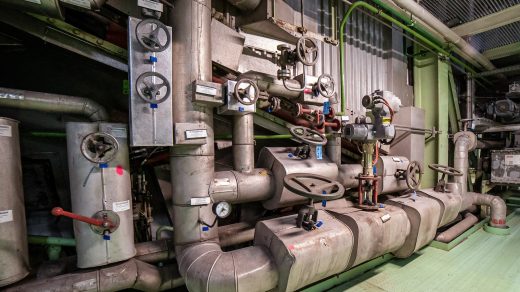Whether you’re a business owner looking to streamline your operations or someone interested in pursuing a career in warehousing, this comprehensive guide is here to provide you with all the information you need. In today’s fast-paced world, efficient and effective storage and distribution of goods are crucial for businesses to stay competitive. Warehousing plays a vital role in this process by providing a safe and organized space for storing, handling, and distributing goods. In this guide, we will cover the fundamentals of warehousing, including its role in supply chain management, types of warehouses, and key processes involved. So let’s get started on our journey to becoming warehousing experts!

The Importance of Warehousing in Supply Chain Management
Warehousing is an integral part of the supply chain management process. It acts as a bridge between the production and distribution stages, ensuring a smooth flow of goods from manufacturers to end consumers. Without warehousing, the logistics and transportation of goods would be chaotic and inefficient, resulting in delayed deliveries and increased costs for businesses. Moreover, warehouses also provide value-added services such as packaging, labeling, and quality control, making them essential in ensuring the overall quality of products. As such, understanding the role of warehousing is crucial for businesses to optimize their supply chain and meet customer demands effectively.
Maximizing Space and Efficiency in Warehouse Layouts
Maximizing space and efficiency in warehouse layouts is essential for businesses to optimize their storage capacity and streamline their operations. A well-designed warehouse layout takes into account factors such as product flow, accessibility, and safety. By carefully planning the placement of racks, shelves, and equipment, businesses can make the most out of their available space while ensuring the smooth movement of goods within the facility. To outfit your warehouse, consider the size and weight of products, as well as their frequency of movement, to determine the most suitable layout. Additionally, incorporating technology such as automated storage and retrieval systems can also greatly improve efficiency in warehousing operations.
Understanding the Different Types of Warehouses
Warehouses are no longer just big, empty buildings with rows of shelves. With the growth of e-commerce and globalization, the demand for specialized warehousing has increased. Understanding the different types of warehouses is crucial in determining which type best fits your business needs. Some common types include fulfillment centers, cold storage warehouses, distribution centers, and cross-docking facilities. Each type caters to specific industries and products, such as perishable goods, large equipment, or e-commerce fulfillment.
Key Processes Involved in Warehousing Operations
Key processes involved in warehousing operations include receiving, putaway, storage, picking, packing, and shipping. Receiving involves checking the goods for accuracy and quality before accepting them into the warehouse. Putaway is the process of storing products in their designated locations within the warehouse. Storage refers to maintaining inventory levels and organizing products for efficient retrieval. Picking is the process of selecting and gathering products to fulfill customer orders. Packing involves preparing items for shipment, including labeling and packaging. Finally, shipping is the process of loading products onto outgoing vehicles for delivery to customers or other warehouses.
Inventory Management
Effective inventory management involves tracking, organizing, and controlling the flow of goods within a warehouse to ensure optimal inventory levels are maintained. Some best practices for successful inventory management include implementing an inventory control system, using real-time data monitoring, conducting regular stock audits, and adopting lean principles such as just-in-time inventory. By continuously evaluating and adjusting inventory levels, businesses can reduce waste and improve efficiency in their warehousing operations. Also, having a clear understanding of demand forecasting and maintaining good supplier relationships can significantly impact inventory management success.
The Role of Technology in Modern Warehousing
Technology has revolutionized the warehousing industry, making operations more efficient and accurate. From automated storage systems to inventory tracking software, technology plays a crucial role in modern warehousing. With the rise of e-commerce and demand for faster order fulfillment, warehouse management systems have become essential in streamlining processes and reducing human error. In addition, technologies such as RFID (Radio Frequency Identification) and barcode scanning have greatly improved inventory accuracy and tracking. As the industry continues to evolve, businesses need to stay updated on the latest technological advancements in warehousing to remain competitive in today’s market.
Ensuring Safety and Security in Warehouse Operations
Safety and security are of utmost importance in warehouse operations. With heavy machinery, high shelves, and numerous workers moving around, warehouses can be hazardous environments if proper safety measures are not taken. Conduct regular safety inspections, provide training for employees on equipment operation and handling of goods, and enforce strict safety protocols. Implementing security measures such as surveillance systems and access controls can help prevent theft and unauthorized access to the facility. Businesses must prioritize safety and security in warehouse operations, as this ensures a secure and risk-free working environment for employees, while also safeguarding valuable inventory.
Implementing Sustainable Practices in Warehousing
With the growing recognition of environmental concerns and the urgent need for sustainable practices, businesses across various industries are increasingly embracing eco-friendly measures in their day-to-day operations. This concerted effort extends to the sphere of warehousing, where the adoption of sustainable practices not only contributes to a healthier planet but also presents notable economic advantages. To minimize their environmental impact, warehouses are implementing a range of strategies that go beyond the basics. For instance, the use of energy-efficient lighting and equipment not only reduces electricity consumption but also leads to substantial cost savings over time. Recycling materials, such as packaging materials and waste products, further reduces the amount of waste sent to landfills and conserves valuable resources. In addition, optimizing transportation routes through advanced logistics systems helps minimize fuel consumption and emissions, contributing to a greener supply chain. The concept of the circular economy has gained traction in the warehousing industry. By reusing and repurposing materials, businesses can extend the lifespan of resources, reduce waste generation, and ultimately save on procurement costs. This innovative approach not only aligns with sustainability goals but also fosters a sense of responsibility and stewardship towards the environment.
Warehousing may seem like a simple concept, but it plays a crucial role in the overall success of businesses. By understanding the basics covered in this guide, businesses can optimize their warehousing processes, improve customer satisfaction, and stay ahead of competitors in today’s dynamic market. So whether you’re just starting or looking to improve your current warehousing practices, this guide has got you covered. Let’s start our journey toward becoming warehousing experts together!




This is a very informative and comprehensive guide to the basics of warehousing. I especially liked the section on implementing sustainable practices in warehousing, as this is something that can benefit both the environment and the business. If you are interested in learning more about how to optimize your warehousing operations, you might want to check out this article on cross-docking system (https://www.cleveroad.com/blog/cross-docking-system/), which is a technique that reduces storage and handling costs by eliminating or minimizing the need for warehousing.